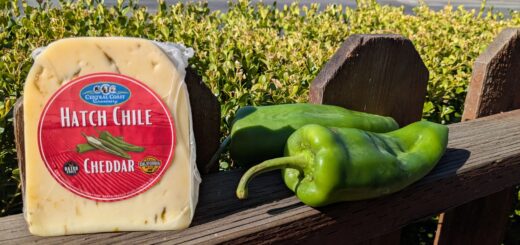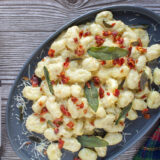Nice to Know Ya, Cherimoya
Nice to Know Ya, Cherimoya
By Robbie Sigona
Have you heard of cherimoya? Would it help if called it by its alias, custard apple? We’ve received many calls from customers asking if it’s cherimoya season, and we’re happy to say the white-fleshed and sweet, custard-like California-grown fruits are finally here and at their peak.
The skin of a cherimoya is not prickly, but it’s not smooth. Most are covered with either bumps or dimples, giving it an air of something similar to a green apple wearing a suit of armor. Others say it resembles its Amazonian cousins, the soursop or guayabana, which have a prickly-looking skin. Unlike its apple look-alike, however, the leathery greenish-brown skin is inedible, as are its numerous black seeds.
Its delicate flesh has a custard-like texture that is pearly white, soft and silky smooth; not unlike an actual creamy dessert custard. The flavor of cherimoya combines attributes of apple, passion fruit, banana, mango, and pineapple into a unique profile of its own.
With this tropical flavor comparison, you may be surprised to learn these delicate fruits come to us from the Santa Barbara hills in Southern California. It’s rare that you’ll see cherimoyas in big chain grocery stores as they’re more of a specialty item and are usually a bit on the expensive side. Cherimoya are very delicate and are even hand-pollinated by growers because the flowers are often closed to tightly for bees to get in to pollinate.
The cherimoya is believed to be native to the South American Andes Mountains near Ecuador where it was originally discovered in the inter-Andean valleys. In the late nineteenth century it was brought to California where it is now grown in the coastal and foothill regions of the southern part of the state. Sigona’s is currently carrying Bay variety cherimoyas, which are typically light green and heart-shaped with an approximate three to four inch diameter. They’ll likely be in season through the end of May and into June.
A small cherimoya contains about 231 calories and is high in vitamins C, B6 and minerals, such as potassium and manganese. It’s a great source of dietary fiber. Though cherimoyas can be used to make a variety of desserts and drinks, this is a fruit that is typically eaten on its own after being chilled. To access the creamy, white flesh, cut the cherimoya in half lengthwise and simply scoop it out with a spoon (as you would an avocado).
Once the cherimoya has been halved, we recommend squirting on a bit of lemon or lime juice to keep it from darkening (again, like an avocado or apple). Cherimoyas can also be peeled and cut into pieces or puréed and used in salsas, seafood dishes, mousses, dessert sauces, pie fillings or creamy drinks. Cherimoya is particularly tasty after having been frozen – they become an amazing and completely natural alternative to ice cream! You can find more recipes here.
There is nothing quite like sub-tropical fruit in early spring! Try a Cherimoya today and you won’t be disappointed.











